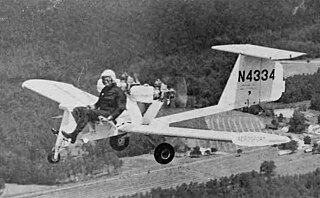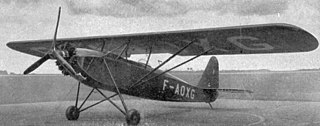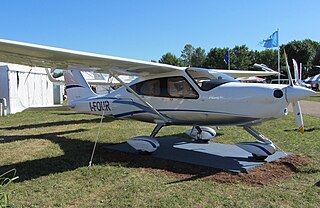
The Barrows Bearhawk, now also called the Bearhawk 4-Place, is an American amateur-built aircraft, designed by Bob Barrows and produced by R&B Aircraft of Fincastle, Virginia, AviPro Aircraft and now Bearhawk Aircraft of Austin, Texas. The aircraft is supplied as a kit or as plans for amateur construction.

The SOCATA TBM is a family of high-performance single-engine turboprop business and utility light aircraft manufactured by Daher. It was originally collaboratively developed between the American Mooney Airplane Company and French light aircraft manufacturer SOCATA.

The Diamond DA40 Diamond Star is an Austrian four-seat, single-engine, light aircraft constructed from composite materials. Built in both Austria and Canada, it was developed as a four-seat version of the earlier DA20 by Diamond Aircraft Industries.

The Aerosport Rail is an American minimalist ultralight aircraft, designed by Harris Woods and built by Aerosport Inc. The aircraft was first flown on 14 November 1970.

The UltraFlight Lazair is a family of Canadian designed and built twin-engine ultralight aircraft that were sold in kit form between 1979 and 1984.

The Salmson Cricri ("Cricket") was a French light aircraft of the 1930s.
The Zenair Zipper is a Canadian ultralight high-wing, single seat aircraft that was designed by Chris Heintz and produced by Zenair.

The Aero-Works Aerolite 103 is an American single seat, high-wing, pusher configuration ultralight aircraft, designed by Terry Raber and introduced by Aero-Works, Inc, of Millersburg, Ohio, in 1997. The aircraft's model number indicates that it was designed to comply with the Federal Aviation Administration FAR 103 ultralight rules.

The Flightstar is a large family of single and two-seat, high wing, single engined kit aircraft that was produced by Flightstar Sportplanes of South Woodstock, Connecticut. In 2009 the rights, tooling and parts inventory were sold to Yuneec International of China when Flightstar Sportplanes' business was wound up.
Electravia - Helices E-Props is a French aviation manufacturer based in Vaumeilh, specializing in the non-certified light aviation sector. At one time it produced electric propulsion systems and now designs and manufactures carbon fibre propellers for light aircraft.

The Tecnam 2010 is a four-seat, high wing, single engine light aircraft of mixed metal and carbon-fiber-reinforced polymer construction. Designed and built in Italy, it was first presented in public in April 2011.

The Colomban MC-30 Luciole is an ultra-lightweight plans-built single-seat low-wing tail-dragger monoplane, designed by the French aeronautical engineer Michel Colomban, creator of the tiny single-seat Colomban Cri-cri twin-engined aircraft and the MC-100 Ban-Bi two-seat aircraft.

The Pipistrel Alpha Trainer is a Slovenian two-seat, single-engine light-sport aircraft intended specifically for flight training, designed and produced by Pipistrel in Gorizia, Italy.

The Aurore MB 02 Souricette is a French ultralight aircraft, designed by Michel Barry and produced by Aurore Sarl of Sauvagnon. The aircraft is supplied as a kit or as plans for amateur construction.

The Protoplane Ultra is a French ultralight aircraft, designed and produced by Protoplane of Bagnères-de-Bigorre. The aircraft is supplied as a complete ready-to-fly aircraft.
The Aérostructure Lutin 80, earlier known as the PLM 80, is a small, single seat motor glider with a low power pusher configuration engine, designed and built in France in the 1980s. Only two were completed.

The Electravia Electro Trike is a French electric ultralight trike, produced by Electravia of Alpes de Haute Provence. The aircraft is supplied as a complete ready-to-fly-aircraft.
The Liaoning Ruixiang RX1E is a Chinese two-seat electric aircraft, designed by the Liaoning General Aviation Academy at Shenyang Aerospace University and manufactured by the Liaoning Ruixiang General Aviation Manufacture Company Limited of Shenyang.

The Pipistrel Velis Electro is a Slovenian light aircraft, designed and produced by Pipistrel of Ajdovščina. The aircraft was EASA CS-LSA fully electric type certified in June 2020 and it is intended primarily for the training aircraft role, particularly multiple successive take-off and landings at the airfield. The design is the first type certified electric aircraft and is supplied complete and ready-to-fly.

















